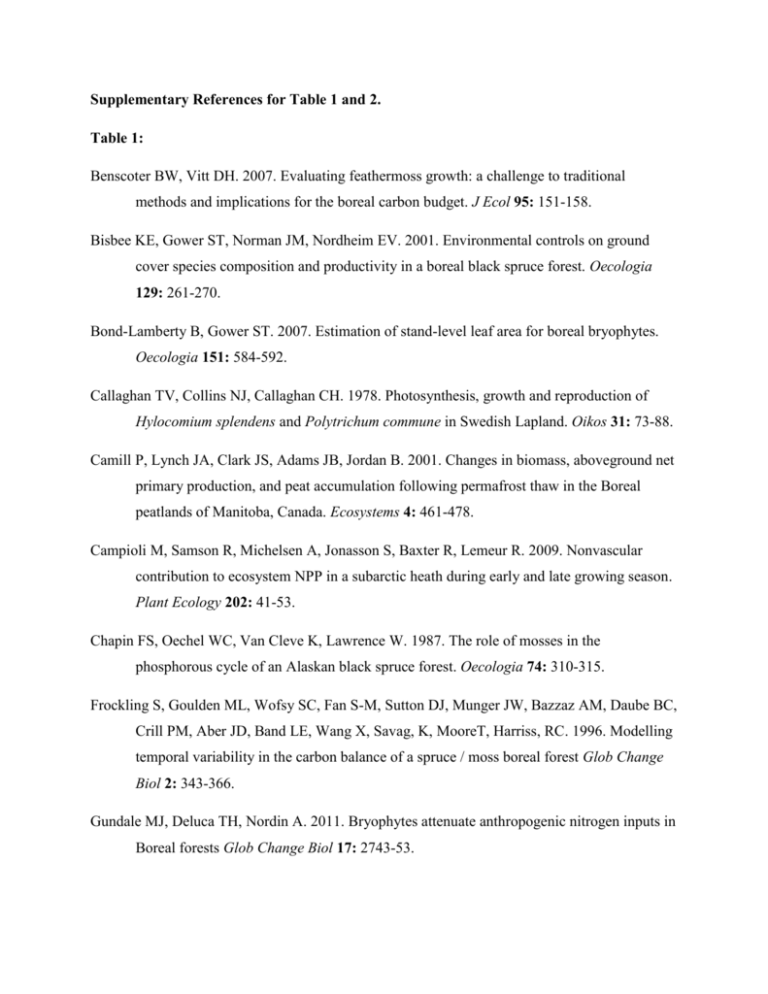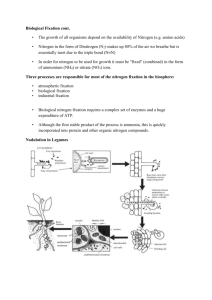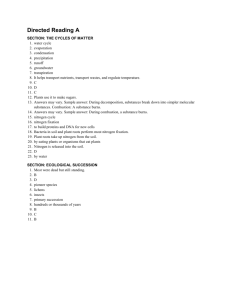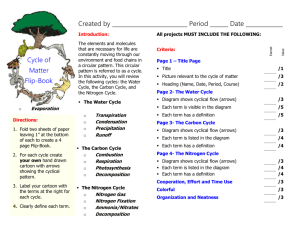gcb12175-sup-0001-SupportingInformation
advertisement

Supplementary References for Table 1 and 2. Table 1: Benscoter BW, Vitt DH. 2007. Evaluating feathermoss growth: a challenge to traditional methods and implications for the boreal carbon budget. J Ecol 95: 151-158. Bisbee KE, Gower ST, Norman JM, Nordheim EV. 2001. Environmental controls on ground cover species composition and productivity in a boreal black spruce forest. Oecologia 129: 261-270. Bond-Lamberty B, Gower ST. 2007. Estimation of stand-level leaf area for boreal bryophytes. Oecologia 151: 584-592. Callaghan TV, Collins NJ, Callaghan CH. 1978. Photosynthesis, growth and reproduction of Hylocomium splendens and Polytrichum commune in Swedish Lapland. Oikos 31: 73-88. Camill P, Lynch JA, Clark JS, Adams JB, Jordan B. 2001. Changes in biomass, aboveground net primary production, and peat accumulation following permafrost thaw in the Boreal peatlands of Manitoba, Canada. Ecosystems 4: 461-478. Campioli M, Samson R, Michelsen A, Jonasson S, Baxter R, Lemeur R. 2009. Nonvascular contribution to ecosystem NPP in a subarctic heath during early and late growing season. Plant Ecology 202: 41-53. Chapin FS, Oechel WC, Van Cleve K, Lawrence W. 1987. The role of mosses in the phosphorous cycle of an Alaskan black spruce forest. Oecologia 74: 310-315. Frockling S, Goulden ML, Wofsy SC, Fan S-M, Sutton DJ, Munger JW, Bazzaz AM, Daube BC, Crill PM, Aber JD, Band LE, Wang X, Savag, K, MooreT, Harriss, RC. 1996. Modelling temporal variability in the carbon balance of a spruce / moss boreal forest Glob Change Biol 2: 343-366. Gundale MJ, Deluca TH, Nordin A. 2011. Bryophytes attenuate anthropogenic nitrogen inputs in Boreal forests Glob Change Biol 17: 2743-53. Harden JW, O’Neill KP, Trumbore SE,Veldhuis SE, Stocks BJ. 1997. Moss and soil contributions to the annual net carbon flux of a maturing boreal forest. J Geophys Res 102: 28805-28816. Mäkipää R. 1995. Sensitivity of forest floor mosses in boreal forests to nitrogen and sulfur deposition. Water, Air Soil Pollution 85: 1239-1244. Natali SM, Schuur EAG, Rubin RL. 2012. Increased plant productivity in Alaskan tundra as a result of experimental warming of soil and permafrost. J Ecology 100: 488-498. Oechel WC, Van Cleve K. 1986. The role of bryophytes in nutrient cycling in the taiga: In Forest Ecosystems in the Alaskan Taiga (eds Van Cleve et al.), pp 121-137. Springer. Vogel JG, Gower ST. 1998. Carbon and nitrogen dynamics of boreal jack pine stands with and without a green alder understory. Ecosystems 1: 386-400. Table 2: Bowman WD, Schardt JC, Schmidt SK. 1996. Symbiotic N2-fixation in alpine tundra: ecosystem input and variation in fixation rates among communities. Oecologia 108: 345-350. Chapin DM, Bliss LC, Bledsoe LJ. 1991. Environmental regulation of nitrogen fixation in a high Arctic lowland ecosystem. Can J Bot 69: 2744-55. Cleveland CC, Townsend AR, Schimel DS, Fisher H, Howarth RW, Hedin LO, Perakis SS, Latty EF, Von Fischer JC, Elseroad A, Wasson MF. 1999. Global patterns of terrestrial biological nitrogen (N2) fixation in natural ecosystems. Glob Biogeochemical Cycles 13: 623-645. DeLuca TH, Zackrisson O, Nilsson M-C, Sellstedt A. 2002. Quantifying nitrogen-fixation in feather moss carpets of Boreal forests. Nature 419: 917-920. DeLuca TH, Zackrisson O, Gentili F, Sellstedt A, Nilsson M-C. 2007. Ecosystem controls on nitrogen fixation in boreal feather moss communities. Oecologia 125: 121-130. DeLuca TH, Zackrisson O, Gundale MJ, Nilsson M-C. 2008. Ecosystem feedbacks and nitrogen fixation in Boreal forests. Science 320: 1181. Deslippe JR, Egger KN,Henry GHR. 2005. Impacts of warming and fertilization on nitrogenfixing microbial communities in the Canadian High Arctic. FEMS Microbiol Ecol 53: 4150. Gavazov, KS, Soudzilovskaia NA, van Logtestijn RSP, Braster M, Cornelissen JHC. 2010. Isotopic analysis of cyanobacterial nitrogen fixation associated with subArctic lichen and bryophyte species. Plant Soil 333: 507-517. Gentili F, Nilsson M-C, Zackrisson O, DeLuca TH, Sellstedt A. 2005. Physiological and molecular diversity of feather moss associative N2-fixing cyanobacteria. J Exp Bot 56: 3121-27. Gundale MJ, Gustafsson H, Nilsson M-C. 2009. The sensitivity of nitrogen fixation by a feathermoss-cyanobacteria association to litter and moisture variability in young and old Boreal forests. Can J Forest Res 39: 2542-49. Gundale MJ, Wardle DA, Nilsson M-C. 2010. Vascular plant removal effects on biological Nfixation vary across a Boreal forest island gradient. Ecology 91: 1704-1714. Gundale MJ, Deluca TH, Nordin A. 2011. Bryophytes attenuate anthropogenic nitrogen inputs in Boreal forests. Glob Change Biol 17: 2743-53. Henriksson E, Henriksson LE, Norrman JO, Nyman PO. 1987. Biological dinitrogen fixation (acetylene-reduction) exhibited by blue-green-algae (cyanobacteria) in association with mosses gathered on Surtsey, Iceland. Arctic Alpine Res 19: 432-436. Ininbergs K, Bay G., Rasmussen U, Wardle DA, Nilsson M-C. 2011. Composition and diversity of nifH genes of nitrogen-fixing cyanobacteria associated with Boreal forest feather mosses. New Phytol 192: 507-517. Jackson BG, Martin P, Nilsson M-C, Wardle DA. 2011. Response of feather moss associated N2 fixation and litter decomposition to variations in simulated rainfall intensity and frequency. Oikos 120: 570-581. Lagerström A, Nilsson M-C, Zackrisson O, Wardle DA. 2007. Ecosystem input of nitrogen through biological fixation in feather mosses during ecosystem retrogression. Functional Ecol 21: 1027-1033. Lindo Z, Whiteley JA. 2011. Old trees contribute bio-available nitrogen through canopy bryophytes. Plant Soil 342: 141-148. Markham JH. 2009. Variation in moss associative nitrogen fixation in Boreal forests. Oecologia 161: 353-359. Matzek V, Vitousek PM. 2003. Nitrogen fixation in bryophytes, lichens, and decaying wood along a soil–age gradient in Hawaiian montane rain forest. Biotropica 35: 12-19. Menge DNL, Hedin LO. 2009. Nitrogen fixation in different biogeochemical niches along a 120,000-year chronosequence in New Zealand. Ecology 90: 2190-2201. Smith VR. 1984. Effects of abiotic factors on acetylene reduction by cyanobacteria epiphytic on moss at a Sub-Antarctic island. Appl Environ Microbiology 48: 594-600. Solheim B, Endal A, Vigstad H. 1996. Nitrogen fixation in Arctic vegetation and soils from Svalbard, Norway. Polar Biol 16: 35-40. Sonesson M. 1967. Studies on mire vegetation in Torneträsk area Northern Sweden: I. Regional aspects. Botaniska Notiser 120: 272-296. Sorensen PL, Michelsen A. 2011. Long-term warming and litter addition affects nitrogen fixation in a subarctic heath. Glob Change Biol 17: 528-537. Sorensen PL, Jonasson S, Michelsen A. 2006. Nitrogen fixation, denitrification, and ecosystem nitrogen pools in relation to vegetation development in the subarctic. Arctic Alpine Res 38: 263-272. Stewart KJ, Coxson D, Grogan P. 2011. Nitrogen inputs by associative cyanobacteria across a low Arctic tundra landscape. Arctic Alpine Res 43: 267-278. Stewart KJ, Coxson D, Siciliano SD. 2011. Small-scale spatial patterns in N2 fixation and nutrient availability in an arctic hummock-hollow ecosystem. Soil Biol Biochem 43: 133140. Van Cleve K, Alexander V. 1981. Nitrogen cycling in tundra and boreal ecosystems. Ecol. Bull. (Stockholm) 3: 375-404. Zackrisson O, DeLuca TH, Nilsson M-C, Sellstedt A, Berglund LM. 2004. Nitrogen-fixation increases with successional age in Boreal forests. Ecology 85: 3327-34. Zackrisson O, DeLuca TH, Gentili F, Sellstedt A, Jäderlund A. 2009. Nitrogen fixation in mixed Hylocomium splendens moss communities. Oecologia 160: 309-319. Zielke M, Solheim B, Spjelkavik S, Olsen RA. 2005. Nitrogen fixation in the high arctic: role of vegetation and environmental conditions. Arctic Alpine Res 37: 372-378.








